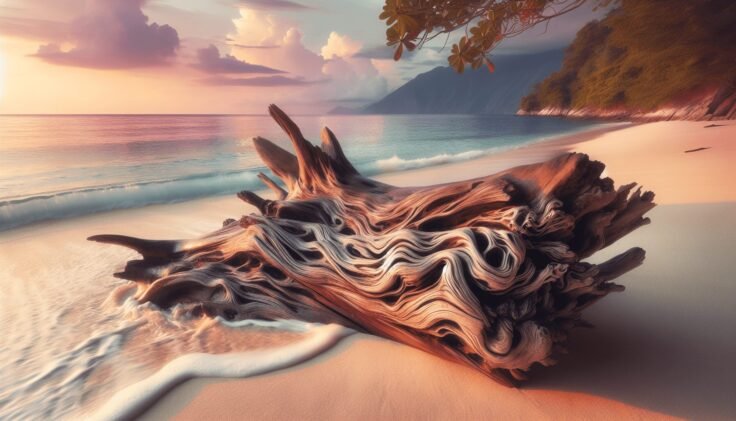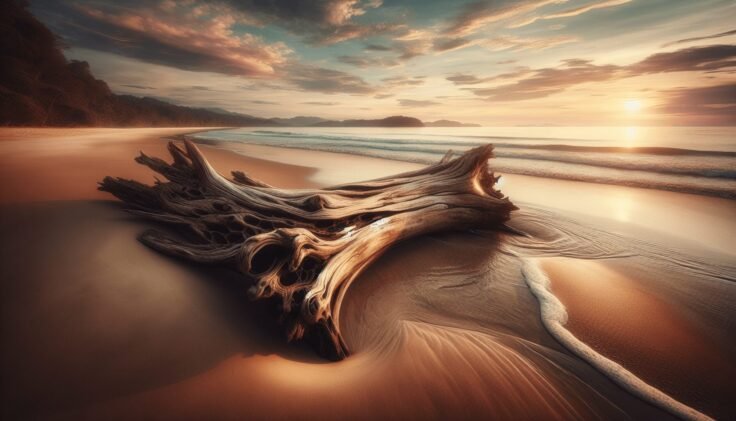Have you ever walked along the beach, gazing at the scattered pieces of driftwood along the shoreline, and wondered about their journey? Each piece has a story to tell, carrying whispers of its travels through rivers, seas, and oceans. In this Driftwood Editorial, let’s embark on a journey to understand the essence of driftwood—its formation, significance, uses, and the incredible artistry it inspires.
Understanding Driftwood
Driftwood is not just a random piece of wood; it’s a testament to nature’s artistry, shaped by the elements over time. It begins its journey as fallen trees and branches washed away by rivers and streams. This journey can be both fascinating and enlightening as you explore the science behind driftwood and its many transformations.
The Journey of Driftwood
The journey of driftwood starts in the forest or along riverbanks, where fallen wood is carried by flowing water into rivers and then into the sea. This journey can span years, with the wood being shaped and smoothed by water, wind, and salt. As a result, each piece of driftwood is unique, with its own texture, shape, and size.
The Science of Driftwood
Understanding the science behind driftwood involves looking at how water, wind, and time work together to create something so captivating. The water erodes the softer parts of the wood, leaving behind intricate designs. Meanwhile, the salt in the sea bleaches the wood and acts as a preservative. Wind and sun also play a role, drying and further refining the wood’s appearance.
The Significance of Driftwood
Driftwood is more than just a beautiful piece of nature; it carries ecological significance and cultural meanings. It provides habitats for creatures and has spiritual and artistic value for humans.
Ecological Importance
Driftwood plays a critical role in various ecosystems. It serves as a natural habitat for fish and other aquatic creatures, acting as shelter and breeding grounds. On land, driftwood helps prevent beach erosion by trapping sand and creating barriers that help protect the shorelines.
Cultural and Spiritual Symbolism
Throughout history, many cultures have attributed spiritual and symbolic meanings to driftwood. For some, it represents transformation and change, embodying the concept of life’s ever-flowing journey. Others see driftwood as a symbol of strength and resilience, as it withstands the trials of water and time to become something uniquely beautiful.

Creative Uses of Driftwood
From practical applications to inspiring artistic creations, driftwood’s versatility knows no bounds. It is a cherished material among DIY enthusiasts, designers, and artists who transform these natural pieces into functional and aesthetic works.
Driftwood in Home Decor
Driftwood has found a special place in home decor, offering a rustic yet elegant touch to interiors. Whether used as a centerpiece, in frames, or to create furniture, driftwood adds a natural and earthy feel to any space.
Artistic Creations
Artists around the world have been inspired by the natural beauty of driftwood, creating stunning sculptures and art pieces. From abstract forms to carefully crafted figures and installations, driftwood art showcases creativity blending with nature.
DIY Projects with Driftwood
For those who love hands-on projects, driftwood offers endless possibilities. You can create your own unique pieces, whether it’s a candle holder, a mirror frame, or even holiday decorations. Using simple tools and techniques, driftwood can become a masterpiece under your careful crafting.
Caring for Driftwood
Once you’ve collected or acquired driftwood, knowing how to care for and preserve it can ensure its beauty lasts for years to come. Proper care is essential to maintain its color and texture while avoiding issues like decay or damage.
Cleaning and Preserving Driftwood
Before using driftwood in your home or projects, it’s important to clean and preserve it properly. Cleaning driftwood involves removing dirt, algae, and insects, often achieved by soaking it in water with a bit of bleach. Following the cleaning process, it should be dried slowly to prevent cracking. Preserving can involve applying a clear finish that protects the wood and enhances its natural beauty.
Avoiding Common Mistakes
Mistakes in driftwood care can lead to quick deterioration. Avoid placing your driftwood in direct sunlight for extended periods, as it can lead to fading and cracking. Similarly, extreme temperature changes can also cause the wood to become brittle. Using protective measures like finishes and keeping it in stable environments can extend its life considerably.

The Fascination with Driftwood
The global fascination with driftwood is evident in its widespread use and the unique creativity it inspires. Whether in cultural artifacts, modern art, or everyday home decor, driftwood captivates those who appreciate natural beauty and the stories it carries.
Driftwood in Historical Contexts
In historical contexts, driftwood has been used by indigenous cultures for practical tools, ceremonial objects, and even in construction. Each culture has developed its unique connection to driftwood, and these traditions often carry profound meanings and stories passed down through generations.
Modern Driftwood Trends
In contemporary settings, driftwood has become a beloved material among designers and artists for its sustainability and unique character. The modern driftwood trend encompasses everything from minimalist decor to elaborate installations seen in art galleries. Its appeal continues to grow as people seek sustainable and natural elements in their living spaces.
Driftwood and Sustainability
Beyond its beauty and utility, driftwood is a sustainable resource, often highlighting the importance of environmental conservation and responsible use of natural materials.
Sustainable Collection Practices
When collecting driftwood, it’s crucial to follow sustainable practices. This means understanding local laws and regulations, as some areas protect driftwood due to its ecological importance. Collect only what you need and leave enough behind to continue supporting local wildlife and ecosystems.
The Environmental Impact of Driftwood Use
Utilizing driftwood is a way to embrace recycling and upcycling, as it repurposes naturally discarded wood without contributing to deforestation. By using driftwood, you contribute to eco-friendly practices that help protect forests and biomes worldwide.
Driftwood in Outdoor Spaces
Driftwood’s charm is not confined to indoor settings; it’s wonderfully suited to enhancing outdoor spaces as well. Whether in your garden or as part of a landscape design, driftwood adds a natural and artistic element to the environment.
Incorporating Driftwood in Gardens
Driftwood can enhance the aesthetic appeal of gardens. It can be used to line pathways, as a functional structure like a bench or arch, or even as an ornamental feature amidst greenery. Its rustic texture and neutral tones complement plant life beautifully.
Driftwood in Landscaping
In landscaping, driftwood is perfect for creating focal points or accentuating water features. Its organic form adds a sense of flow and continuity in larger outdoor settings. With its durability against the elements, driftwood becomes a long-lasting feature in any landscape.
Finding Inspiration with Driftwood
For those looking to start their own driftwood projects or simply seeking inspiration, the possibilities are as boundless as the ocean itself. Driftwood invites creativity, offering unique opportunities for personalization and expression.
Nature as Your Muse
Let nature inspire your driftwood creations. Each piece of driftwood comes with its own inherent beauty and form, guiding your vision and creative process. Whether you seek harmony or contrast, driftwood provides a starting point to explore and experiment.
Driftwood Community and Resources
Join communities of driftwood enthusiasts and artists who share a passion for creating and storytelling. Online forums, workshops, and social media platforms offer a wealth of ideas and tips, connecting you to others who appreciate this remarkable material. Sharing your creations also adds to the collective appreciation and innovation of driftwood artistry.
Conclusion
Driftwood is not merely debris washed ashore; it is a narrative of nature, time, and transformation. Its journey invites you to discover beauty in what was once overlooked, creating space for reflection and creativity. As you engage with driftwood through art, decor, or simply admiration, you embrace the timeless cycle of nature’s artistry and its power to inspire.